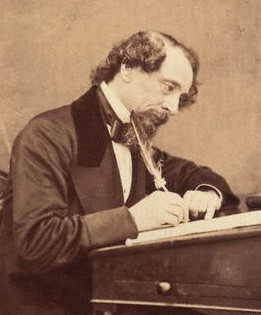22 Biography

Charles John Huffam Dickens was born in Landport, Portsmouth, England, on February 7, 1812. Charles was the second of eight children to John Dickens (1786–1851), a clerk in the Navy Pay Office, and his wife Elizabeth Dickens (1789–1863). The Dickens family moved to London in 1814 and two years later to Chatham, Kent, where Charles spent early years of his childhood. Due to financial difficulties, they moved back to London in 1822, where they settled in Camden Town, a poor neighborhood of London.
The defining moment of Dickens’s life occurred when he was 12 years old. His father, who had a difficult time managing money and was constantly in debt, was imprisoned in the Marshalsea debtor’s prison in 1824. Consequently, Charles was withdrawn from school and forced to work in a warehouse that handled “blacking” or shoe polish to help support the family. This experience left profound psychological and sociological effects on Charles. It gave him a firsthand acquaintance with poverty and made him the most vigorous and influential voice of the working classes of his time.
After a few months, Dickens’s father was released from prison and Charles was allowed to go back to school. At age 15, his formal education ended and he found employment as an office boy at a law office. During this time, he studied shorthand at night, and from 1830 he worked as a shorthand reporter in the courts and afterwards as a parliamentary and newspaper reporter.
In 1833, Dickens began to contribute short stories and essays to periodicals. “A Dinner at Popular Walk” was Dickens’s first published story. It appeared in the Monthly Magazine in December 1833. In 1834, still a newspaper reporter, he adopted the soon-to-be famous pseudonym Boz. Dickens’s first book, a collection of stories titled Sketches by Boz, was published in 1836. In the same year, he married Catherine Hogarth, daughter of the editor of the Evening Chronicle. Together they had 10 children before they separated in 1858.
Although Dickens’s main profession was as a novelist, he continued his journalistic work until the end of his life, editing The Daily News, Household Words, and All the Year Round. His connections to various magazines and newspapers gave him the opportunity to begin publishing his own fiction at the beginning of his career.
The Posthumous Papers of the Pickwick Club was published in monthly parts from April 1836 to November 1837. Pickwick became one of the most popular works of the time, continuing to be so after it was published in book form in 1837. After the success of Pickwick, Dickens embarked on a full-time career as a novelist, producing work of increasing complexity at an incredible rate: Oliver Twist (1837–39), Nicholas Nickleby (1838–39), The Old Curiosity Shop, and Barnaby Rudge as part of the Master Humphrey’s Clock series (1840–41), all being published in monthly installments before being made into books.
In 1842, he travelled with his wife to the United States and Canada, which led to his publishing the controversial American Notes (1842), which is the basis of some of the episodes in Martin Chuzzlewit. Dickens’s series of five Christmas Books were soon to follow: A Christmas Carol (1843), The Chimes (1844), The Cricket on the Hearth (1845), The Battle of Life (1846), and The Haunted Man (1848). After living briefly abroad in Italy (1844) and Switzerland (1846), Dickens continued his success with Dombey and Son (1848), the largely autobiographical David Copperfield (1849-50), Bleak House (1852-53), Hard Times (1854), Little Dorrit (1857), A Tale of Two Cities (1859), and Great Expectations (1861).
In 1856 his success allowed him to buy Gad’s Hill Place, an estate he had admired since childhood. In 1858 Dickens began a series of paid readings, which became instantly popular. In all, Dickens performed more than 400 times. In that year, after a long period of difficulties, he separated from his wife. It was also around that time that Dickens became involved in an affair with a young actress named Ellen Ternan. The exact nature of their relationship is unclear, but it was clearly central to Dickens’s personal and professional life.
In the closing years of his life Dickens worsened his declining health by giving numerous readings. During his readings in 1869 he collapsed, showing symptoms of mild stroke. He retreated to Gad’s Hill and began to work on Edwin Drood, which was never completed.
Charles Dickens died at home on June 9, 1870, after suffering a stroke. Contrary to his wish to be buried in Rochester Cathedral, he was laid to rest in the Poets’ Corner of Westminster Abbey. The inscription on his tomb reads:
“He was a sympathiser to the poor, the suffering, and the oppressed; and by his death, one of England’s greatest writers is lost to the world.”
Used with permission, biography written by Gregor Brdnik, http://www.dickens-online.info/charles-dickens-biography.htm

